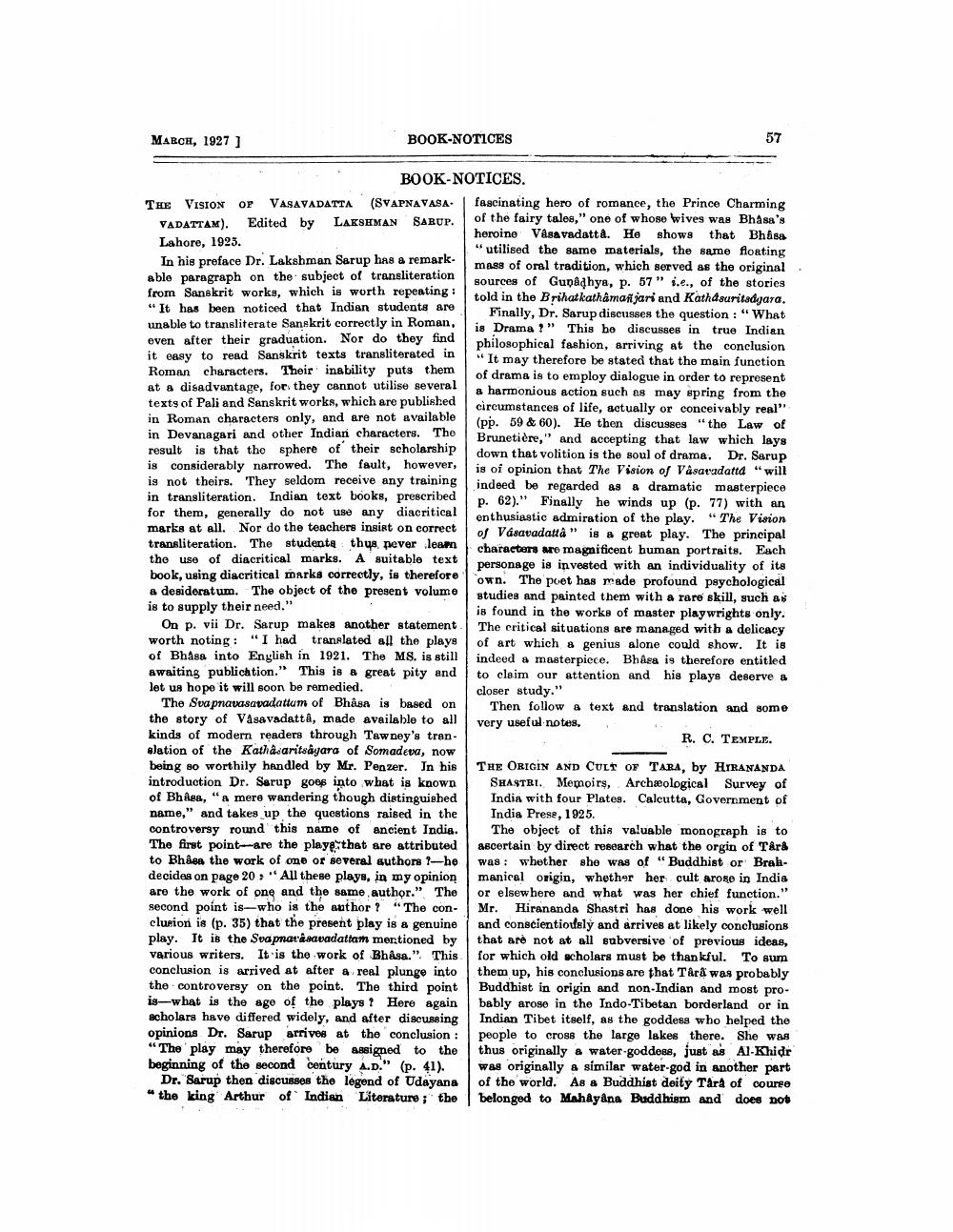________________
MARCH, 1927]
BOOK-NOTICES
57
BOOK-NOTICES. THE VISION OF VASAVADATTA (SVAPNAVASA | fascinating hero of romance, the Prince Charming VADATTAM). Edited by LAKSHMAN SARUP. of the fairy tales," one of whose wives was Bhasa's
heroine Vasavadatta. He shows that Bhise Lahore, 1925.
"utilised the same materials, the same floating In his preface Dr. Lakshman Sarup has a remark
mass of oral tradition, which served as the original able paragraph on the subject of transliteration
sources of Gunadhya, p. 57 " i.e., of the stories from Sanskrit works, which is worth repeating :
told in the Brihatkathâmañ jari and Kathdsuritadyara. " It has been noticed that Indian students are
Finally, Dr. Sarup discusses the question: "What unable to transliterate Sanskrit correctly in Koman. is Drama ?" This be discusses in true Indian even after their graduation. Nor do they find
philosophical fashion, arriving at the conclusion it easy to read Sanskrit texts transliterated in
"It may therefore be stated that the main function Roman characters. Their inability puts them
of drama is to employ dialogue in order to represent at a disadvantage, for they cannot utilise several
a harmonious action such as may spring from the texts of Pali and Sanskrit works, which are published
circumstances of life, actually or conceivably real" in Roman characters only, and are not available
(pp. 59 & 60). He then discusses the Law of in Devanagari and other Indian characters. The
Brunetière," and accepting that law which lays result is that thosphere of their scholarship
down that volition is the soul of drama. Dr. Sarup is considerably narrowed. The fault, however,
is oi opinion that The Vision of Vasaradattd "will is not theirs. They seldom receive any training indeed be regarded as a dramatic masterpiece in transliteration. Indian text books, prescribed
p. 62)." Finally he winds up (p. 77) with an for them, generally do not use any diacritical
enthusiastic admiration of the play. “The Vision marks at all. Nor do the teachers insist on correct
of Vasavadatta " is a great play. The principal transliteration. The studente thus never learn
characters are magnificent buman portraits. Each the use of diacritical marks. A suitable text
personage is invested with an individuality of its book, using diacritical marks correctly, is therefore
own. The poet has made profound psychological a desideratum. The object of the present volume studies and painted them with a rare skill, such as is to supply their need."
is found in the works of master playwrights only. On p. vii Dr. Sarup makes another statement The critical situations are managed with a delicacy worth noting: "I had translated all the playe of art which & genius alone could show. It is of Bhass into English in 1921. The MS. is still indeed a masterpiece. Bhdea is therefore entitled awaiting publication. This is a great pity and to claim our attention and his plays deserve & let us hope it will soon be remedied.
closer study." The Sva pravasavadattum of Bhâsa is based on Then follow a text and translation and some the story of Vasavadatta, made available to all very useful notes, kinds of modern readers through Tawney's tran
R. C. TEMPLE. alation of the Kathacaritsayara of Somadeva, now being so worthily handled by Mr. Penzer. In his | THE ORIGIN AND CULT OF TARA, by HIRANANDA introduction Dr. Serup goes into what is known SHASTRI. Memoirs, Archeological Survey of of Bh Ama, "A mere wandering though distinguished India with four Plates. Calcutta, Government of name," and takes up the questions raised in the India Prese, 1925. controversy round this name of ancient India. The object of this valuable monograph is to The first point--are the plays that are attributed ascertain by direct research what the orgin of Tara to Bhdea the work of one or several authors 1-he was: whether she was of "Buddhist or Brahdecides on page 20; "All these plays, in my opinion manical origin, whether her cult arose in India are the work of one and the same author." The or elsewhere and what was her chief function." second point is-who is the author ? “The con- Mr. Hirananda Shastri has done his work well clusion is (p. 35) that the present play is a genuine and conscientiously and arrives at likely conclusions play. It is the Sva pnatasavadattam mentioned by that are not at all subversive of previous ideas, various writers. It is the work of Bhisa." This for which old scholars must be thankful. To sum conclusion is arrived at after a real plunge into them up, his conclusions are that Tari was probably the controversy on the point. The third point Buddhist in origin and non-Indian and most pro. is-what is the age of the plays ? Here again bably arose in the Indo-Tibetan borderland or in scholars have differed widely, and after discussing Indian Tibet itself, as the goddess who helped the opinions Dr. Sarup arrives at the conclusion: people to cross the large lakes there. She was "The play may therefore be assigned to the thus originally a water-goddess, just as AlKhidr beginning of the second century A.D." (p. 41). was originally a similar water-god in another part
Dr. Sarup then discusses the legend of Udayana of the world. As a Buddhist deity Tara of course "the king Arthur of Indian Literature; the belonged to Mahayana Buddhism and does not




